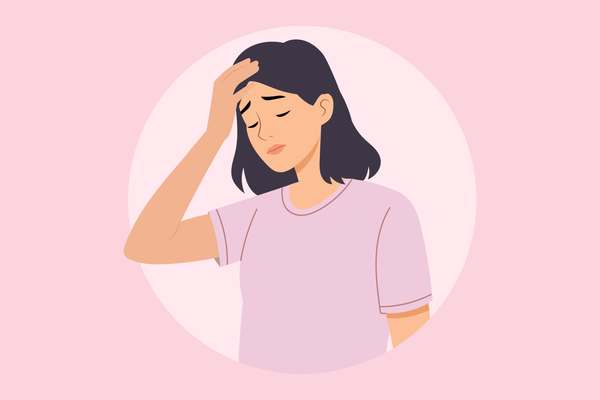June is National Migraine and Headache Awareness Month.
You’ve heard of Botox as a cosmetic procedure — but did you know that Botox is also used as a treatment for several medical conditions, including migraine disease?
We wanted to learn more about how Botox can help with this debilitating disease, so we reached out to Dr. Rashmi B. Halker Singh, a headache neurologist and member of HealthyWomen’s Women’s Health Advisory Council who also has firsthand experience with migraine, to see what she has to say.
What is migraine disease?
Migraine is a neurological, genetic disease that has a complex group of symptoms, including head pain, light and sound sensitivity, nausea, and trouble concentrating. Migraine affects about a billion people worldwide — including one in five women. Though it’s a common condition, its symptoms are often underrecognized. While many are familiar with migraine as a type of headache, a migraine attack actually has four stages: prodrome, aura, headache and postdrome.
To help evaluate whether recurrent headache attacks could be migraine, Halker Singh recommends using the mnemonic “PIN.”
- P: Photophobia, the medical term for light sensitivity
- I: Impairment, meaning you don’t feel like you’re operating on your normal cognitive level
- N: Nausea
If recurrent headaches are accompanied by two out of the three symptoms outlined by “PIN,” there is a good chance that you’re experiencing migraine headaches — as opposed to other types of headache, like tension headaches or sinus headaches.
What is Botox and how can it treat chronic migraine?
Botox is a brand of botulinum neurotoxin that has been made from the bacterium Clostridium botulinum. Although it’s most well-known for its wrinkle-diminishing abilities, Botox treatments can also help lazy eye, excessive sweating (hyperhidrosis), bladder dysfunction and muscle contractions as well as chronic migraine.
Botox has been officially approved, and regulated, by the Food and Drug Administration (FDA) as a treatment for migraine since 2010. Experts still aren't exactly sure how Botox helps prevent migraine attacks, but the current understanding is that Botox likely helps with migraine by preventing pain transmission.
Botox is very successful at preventing migraine attacks. In fact, patients report that after two botox treatments, their number of headache days reduces by 50%. A study in the Journal of Headache and Pain found that after the third treatment, people with chronic migraine reported reduced headache intensity and frequency of headache medication taken as well.
“In clinical trials, on average, patients experience 40 hours less of migraine attacks per month with [Botox], but in my own personal clinical practice, I've seen responses vary significantly,” Halker Singh said. She explained that, in people who find Botox helpful, responses range from complete relief to fewer migraine attacks.
 iStock.com/5./15 WEST
iStock.com/5./15 WEST
Who can receive Botox for migraine?
Botox is a preventive treatment specifically for chronic migraine, which affects 3%-5% of the U.S. population. In order to be diagnosed with chronic migraine, headache attacks must meet migraine criteria. In addition, you must experience any type of headache 15 days a month, and for at least eight of those days, your headache attack must either meet migraine criteria or be prevented by medication before it gets to that point. Finally, this pattern must be stable for at least three months.
If you think you may be a candidate for a chronic migraine diagnosis — and Botox therapy — Halker Singh recommends using a headache diary. “Sometimes when people come in to see me in the clinic, they’re really interested in finding treatment and sometimes what they prioritize is their worst attacks,” Halker Singh explained. “What's really helpful and important to know is what’s happening on those other days. So a headache diary can be really helpful to clarify because if they have any kind of headache on other days, they might have chronic migraine,” she said.
Because the FDA has approved botox treatment for chronic migraine attacks, most insurance companies will cover these treatments, but each insurance company is different. Some require you to go through a process called step therapy first, which may include trying other medications before approving Botox. It’s important to tell your HCP about all the treatments you’ve tried so they can make an informed decision about the best next steps for you.
How are Botox treatments given?
Botox treatments for treatment of migraine consist of 31 injections, targeting seven key muscle groups in the head and neck. Though this may seem like a lot of shots, appointments only last around 20 minutes, and the thin needles make the procedure more comfortable, too. Treatments are administered every 12 weeks.
Should you try Botox for your migraine disease?
Botox is considered an excellent treatment for chronic migraine because it is FDA-approved and generally well-tolerated. If you’re considering using Botox to treat your migraine disease, be sure to talk to your HCP about any potential side effects.
The bottom line is that Botox can be an effective treatment for chronic migraine and has been found to improve patients’ quality of life. If you live with chronic migraine, check with your healthcare provider to find out if Botox is an option for you.
- Just Another Headache? ›
- Most People Who Experience Migraine Are Women: Here's What ... ›
- Botox: Not Just About Vanity - HealthyWomen ›
- A Perfect Storm Migraine Attack Revealed the Limits of My “Push Through the Pain” Philosophy - HealthyWomen ›
- The Migraine Treatment You Don't—But Should—Know About - HealthyWomen ›
- What's Your Headache Type? - HealthyWomen ›
- What Is Botox Used For? - HealthyWomen ›
- How to Know If You’re Experiencing Migraine - HealthyWomen ›
- Self-Care for Migraines - HealthyWomen ›
- Questions and Answers About Migraine Treatments - HealthyWomen ›
- The Relationship Between Migraine and Mental Health - HealthyWomen ›
- La relación entre las migrañas y la salud mental - HealthyWomen ›
- Preguntas y respuestas relacionadas con los tratamientos de migrañas - HealthyWomen ›






